Floater structures in the visual arts of ancient Egypt
By Floco Tausin
In Western culture, the phenomenon of vitreous floaters (or muscae volitantes) is primarily understood in line with modern ophthalmology as “vitreous opacitiesâ€. The review of visual arts from former and non-Western cultures representing mythical and spiritual ideas, however, discloses abstract symbols that resemble the typical structures of eye floaters. This suggests that floaters have been widely interpreted as a mythical or spiritual phenomenon; and that there might be a perceptual dimension of floaters that modern ophthalmology fails to see (Tausin, 2010, 2006b). This article provides a trip to the visual worlds of Pharaonic Egypt and suggests that vitreous floaters have found their way into the art and imagination of this ancient civilization.
The sun
Since the earliest days of the Old Kingdom (from 2800 BC), the sun was due to its life-giving warmth and its regular cycle understood as the manifestation of a deity, the god Ra (or Re). The cult of the sun has been developed in various centers of the kingdom, especially in the “sun cityâ€, Heliopolis. From 15th century BC, it spread rapidly throughout Egypt. In the process, many local and regional deities were identified with Ra. He was imagined and invoked as anthropomorphic creator god Re-Atum in Heliopolis, as Amun-Re in Thebes, as the falcon or hawk Re-Harakhti, as sun rolling scarab Khepri, or as a sun disk (Aten / Aton) which is often an accompanying attribute in the representation of Ra and sun-related deities.
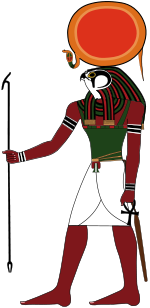
The falcon-headed Ra with sun disk. (http://de.wikipedia.org/wiki/Datei:Sun_god_Ra.svg).
In the Egyptian hieroglyphic writing, the name of Ra is expressed as follows:
![]()
The sign ![]()  (pronounced “re†or “raâ€) is said to represent the sun, but is also used for “dateâ€, “hour†or “timeâ€. It is striking that the sun is symbolized by two concentric circles. In the abstract visual representation of Ra, these circles often become different colored circular disks that are depicted in combination with other elements and symbols. Examples include the scarab Khepri who rolls the sun above the horizon, and the solar boat in which Ra moves across the sky at day and across the underworld at night. Several attributes are often combined with the sun disk to express its power: one or two cobra snakes (uraei), the wings of Horus, as well as hands.
 (pronounced “re†or “raâ€) is said to represent the sun, but is also used for “dateâ€, “hour†or “timeâ€. It is striking that the sun is symbolized by two concentric circles. In the abstract visual representation of Ra, these circles often become different colored circular disks that are depicted in combination with other elements and symbols. Examples include the scarab Khepri who rolls the sun above the horizon, and the solar boat in which Ra moves across the sky at day and across the underworld at night. Several attributes are often combined with the sun disk to express its power: one or two cobra snakes (uraei), the wings of Horus, as well as hands.
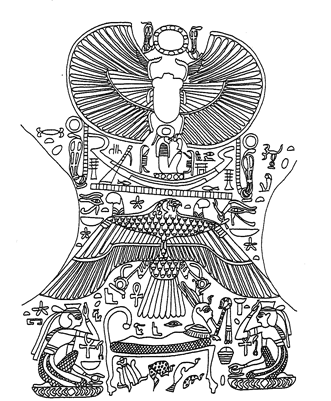
The winged scarab Khepri moves the sun which is protected by two cobra snakes (uraei). Below Khepri: Ra with sun disk in the solar boat. (Uehlinger, 2000, Fig 9).

Winged sun disk, symbol of protection. According to the myth, Horus-Ra, the falcon god associated with the sun god, destroyed the enemies of Ra in the form of the winged sun disk (http://images.zeno.org/Meyers-1905/I/big/180608a.jpg).
The Pharaohs of the 18th dynasty even divided the solar disk (Aten) from anthropomorphic deities and established a cult of its own. Under the rule of Amenhotep IV (a.k.a. Akhenaten or Echnaton, 14th century BC), the solar disk became, for a short time, the only approved deity of Egypt. It was regarded as the essence of the forces of all the gods, as well as the luminous source of all being with which man can become one.
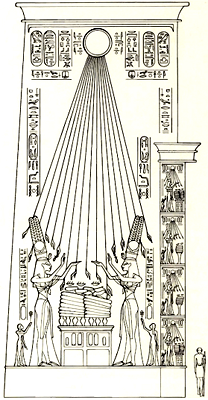
Abstract representation of the solar disk: The rays end in hands that take the offerings and give the Ankh symbol, i.e. Â life and health to man (Redford, 1984, p. 76).
The depiction of the sun, as well as its mythic significance, raises the question whether the symbol ![]()  was actually inspired by the visual perception of the sun, or whether there are other possibilities. If the concentric circles are taken seriously, the sign may give the picture of an eye which would fit the often mentioned eye of Ra which is the sun. If we consider the sign not as stylized and simplified form, as in the case of the sun or the eye, but as realistic depiction of something actually seen, then the vitreous floaters could be the source of that perception. Like the sun, they are often seen at the sky and radiate a brilliant light. Besides the concentric circles, there are other characteristics in ancient Egyptian’s depiction of the “sun†that rather resembles floaters than the sun: The contrast between the surround disk and the core disk is often made clearly distinct by using different colors or patterns; and the proportions of the surround and the core are different in each case, as shown above – this corresponds to the two types of floaters and their different states of concentration (Tausin, 2008).
 was actually inspired by the visual perception of the sun, or whether there are other possibilities. If the concentric circles are taken seriously, the sign may give the picture of an eye which would fit the often mentioned eye of Ra which is the sun. If we consider the sign not as stylized and simplified form, as in the case of the sun or the eye, but as realistic depiction of something actually seen, then the vitreous floaters could be the source of that perception. Like the sun, they are often seen at the sky and radiate a brilliant light. Besides the concentric circles, there are other characteristics in ancient Egyptian’s depiction of the “sun†that rather resembles floaters than the sun: The contrast between the surround disk and the core disk is often made clearly distinct by using different colors or patterns; and the proportions of the surround and the core are different in each case, as shown above – this corresponds to the two types of floaters and their different states of concentration (Tausin, 2008).
Taking into account the accompanying symbols, there are further hints: The sun disk often appears moving within or along with “elongated structures†like snakes, wings or boats. This could point to the floaters strings that often contain, and move along with, the spheres (Tausin, 2010). In Egyptian art, this is especially true of the snakes. On the one hand, cobra snakes, the uraei, are shown to bear and surround – and thus protect – the sun; on the other hand, sun god Ra is said to combat against demon snakes at night while moving through the underworld. From that point of view, and due to their contact and “moving along†with the sun, snakes could be understood as figurative interpretation of floater strings.
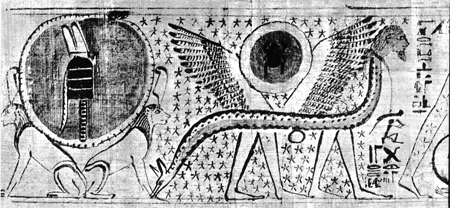
A Snake with legs and wings carries the sun disk. Papyrus (n/a, 1965, p. 26).
The World
The mythic concept of the world inhabited by the ancient Egyptians reveals the same major structure as the sun. Many origin myths have in common the idea of ​​a primeval chaos, often described as original sea or waters (Nun). From this sea a mound or island raises that develops into the world known to the Egyptians. This process is reminiscent of the floaters spheres in which a core appears or disappears, depending on the state of concentration (Tausin, 2008). The Egyptian world itself contains the very same structure: It is a circular disk which includes a plurality of concentric circles. In the spacious surround of the disk on the image below, the foreign countries known to the Egyptians are represented; a middle thin circle contains the symbols of the Egyptian administrative districts; the core of the disk depicts the land of the Nile with its gods and humans. On the top of the surround rests enthroned the winged sun disk.
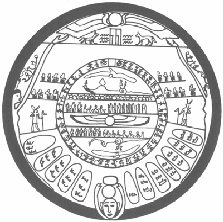
The world according to the ancient Egyptians (4th millennium BC) (Owusu, 1998, p. 13).
Further concentric circles in the arts and crafts
The Egyptian craftwork provides many examples of concentric circles or rings that may be related to the symbolism of the sun and the world – and eventually might be depicting floaters. For example, scenes of everyday work regularly show workers weighting rings of different colors. Scholars argue that these rings represent gold and silver poured into rings of fixed weights (Muller, 141f.). In my opinion, however, it is not entirely clear if they really are rings (without core) or rather disks with cores of different colors, as some paintings suggest. Thus, visually, as well as mythologically – due to its brilliance, gold was associated by the Egyptians with the sun – there is reason to consider the possibility that these workers metaphorically “weight†divine power against rather worldly goods.
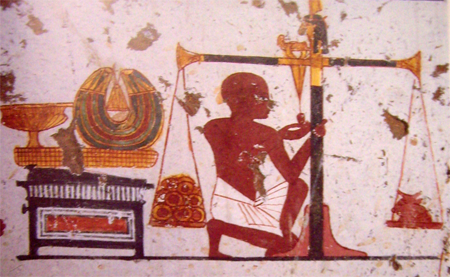
Weighting gold or divine and mythic power? (Mueller / Thiem, 2000, Fig 67).
Not only gold, but also bread may have been associated with the symbolism of the sun, and, therefore, possibly represent floaters. This is suggested by the dotted disks in containers and baskets. Scholars refer to these disks as breads and cakes, provided for soldiers or gods. The latter becomes evident in the many scenes depicting sacrifice rituals; along with water, wine, meat, vegetables and flowers, bread was part of the usual offerings to the gods and the dead. Whether the dotted disk structure of the bread really represents the sun disk, or rather refer to the eye of Horus – for bread was found, according to a myth, in the pupil of Horus’ eye – remains uncertain.
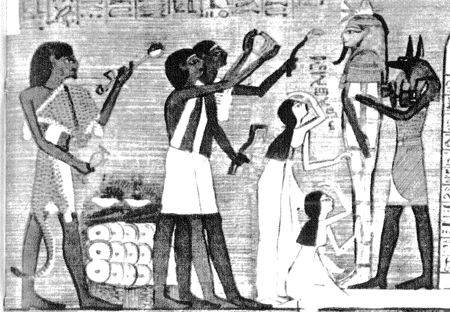
Offerings at the burial of the mummy. Scene from the Book of the Dead. (N / a, 1965, p. 81).
Another famous example of Egyptian handicraft is Khepresh, or the “blue crownâ€. This royal headdress worn by New Kingdom pharaohs from the 18th dynasty is all covered with dotted circles. These may represent the sun disk – or floaters, respectively; other scholarly interpretations include representations of curly hair or tortoise shells.
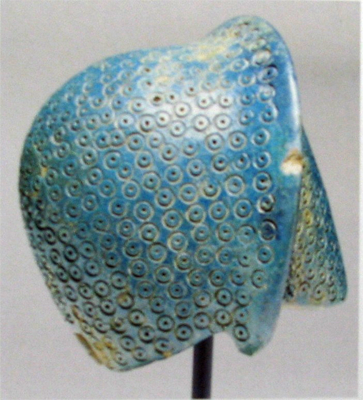
Blue crown, taken from a sculpture, ceramics, 18th dynasty. (Freed, 2002, Fig 63).
Especially from the 18th dynasty, when the abstract solar disk was carried through as the only legitimate god, the concentric circles or dotted disks appear as decorations on many vessels and jewelry. Be they hot glass drops of decreasing size and contrasting colors marvered into the body of a vessel …
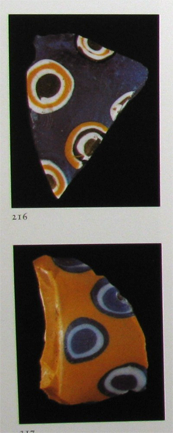
Stratified “eyes†on fragments of vessels (Freed, 2002, Fig 215-217).
… painted on ceramic beads …
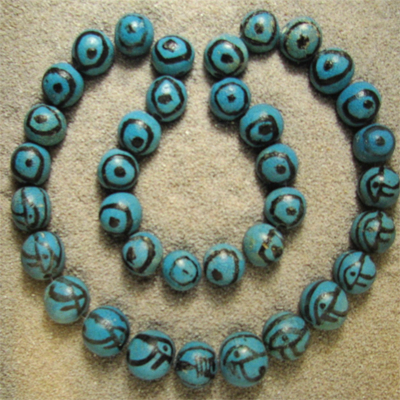
String of eye beads from the time of Akhenaten, 18th dynasty (Freed, 2002, Fig 195).
… or engraved on late stone or ore amulets whose symbolism is uncertain.
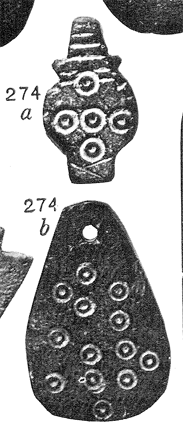
Amulets from the Roman period of ancient Egypt, black soapstone, brown hematite (Flinders Petrie, 1972, Fig 274a / b).
Conclusion: Shamanism in Ancient Egypt?
Attributing abstract and figurative spheres and strings in Egyptian art to eye floaters is possible, but remains speculative. The floaters interpretation would become more valid if Egyptian culture could be shown to be influenced by consciousness altering practices or ecstatic trance. For such practices – which I refer to as shamanic practices – are known to induce or intensify the perception of entoptic phenomena in the practitioners (Tausin, 2006a). According to Egyptologists, the religious traditions of Egypt are about priests ritually worshiping the gods in temples and on the occasion of festivals; the divine representation of the king; and individual practices of magic, as well as funeral and death cults. The Egyptians seem to have lacked practices remote of everyday life like meditation or ecstasy – they seem to have lacked shamanic elements (Assmann 2003, 1984).
A closer look, however, reveals shamanic symbols and themes in texts and illustrations, such as the hybrids of humans and animals, the powerful and creative position of androgynous beings, the adoration of arts and crafts (especially metal working), as well as the symbol of the ladder for the ascent or descent of souls to the heavens or the underworld (Stutley, 2003). Another indication is the use of mind-altering plants. Some cults such as the “festival of drunkenness†to honor the goddess Hathor at Dendera included drinks like beer or wine, music and dance (Assmann, 1984). There is evidence that ancient Egyptian alcoholic beverages have been enriched with hallucinogenic plants like wormwood, mandrake or henbane (Rätsch, 2004; Balababova et al, 1992).
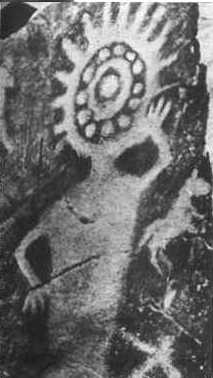
Anthropomorphic being with concentric and dotted halo as head. Tassili, around 6000 BC. http://www.nephilimskulls.com/Articles.asp?ID=149
Finally, recent findings of Upper Paleolithic rock art in Egypt, which is similar to European rock art previously linked to trance states (Huygen et al, 2007; cf. Tausin, 2006a), suggest yet another reason to assume shamanic influences on ancient Egypt culture. Since abstract symbols in stone age rock art such as circles, dots and lines can generally be found in all of North Africa (Ravilious, 2010), it is also possible that some symbols of Egyptian art could have been imported from other regions. A promising site would be Tassili n’Ajjer in Algeria, containing one of the largest collections of stone age rock and cave paintings and engravings, which are attributed by some researchers to shamanic trance experiences induced by hallucinogenic mushrooms. Similarities between the Tassili rock art and the ancient Egyptian visual arts may be explained by possible contacts of (predynastic) Egyptians to the ancestors of the Algerian Tuareg (Coppen 2010). For example, concentric circles or dotted disks are part of the ancient scripture found in Tassili (Tifinagh), as well as part of the Tassili visual art. This Neolithic signs could have spread to Egypt and developed into the Egyptian hieroglyphic and abstract representation of what become known as “Aten†or “sun disksâ€. It may be the very same entoptic sun disks we experience, stare at, or even meditate on, in our visual field.
References:
The pictures are taken from image hosting websites, from scientific publications (online and print) and/or from my own collection (FT). Either they are licensed under a Creative Commons license, or their copyright is expired, or they are used according to the copyright law doctrine of ‘Zitatrecht’, ‘fair dealing’ or ‘fair use’.
n/a. (1965). Egyptian Mythology. London: Paul Hamlyn
Assman, Jan. (1984). Ägypten. Theologie und Frömmigkeit einer frühen Hochkultur. Stuttgart et al.: Kohlhammer
Assman, Jan. (2003). Ägyptische Religion. Handbuch Religionswissenschaft: Religionen und ihre zentralen Themen, ed. by Johan Figl. Innsbruch: Tyrolia
Balababova, S., F. Parsche, and W. Pirsig. (1992). First identification of drugs in Egyptian mummies. Naturwissenschaften 79:358.
Brunner-Traut, Emma. (1976). Die alten Ägypter. Verborgenes Leben unter Pharaonen. Stuttgart: Kohlhammer
Coppen, Philip. (n/a) The Tassili n’Ajjer: birthplace of ancient Egypt? http://www.philipcoppens.com/tassili.html (12.9.10)
Dodelinger, Edmund. (1973). Der Jenseitsweg der Nofretari. BIlder aus dem Grab einer ägyptischen Königin. Graz: Akademische Druck- und Verlagsanstalt
Eliade, Mircea. (1980). Die Schöpfungsmythen. Ägypter, Sumerer, Hurriter, Hethiter, Kanaaniter und Israeliten. Darmstadt: Wissenschaftliche Buchgesellschaft
Erman, Adolf. (1934). Die Religion der Ägypter. Ihr Werden und Vergehen in vier Jahrtausenden. Berlin: De Gruyter
Fazzini, Richard A. (1988). Egypt. Dynasty XXII-XXV. (Iconography of Religions XVI, ed. by. Th. P. van Baaren et al.) Leiden: Brill
Flinders Petrie, W. M. (1972). Amulets. Warminster: Aris & Phillips LTD
Freed, Rita E. et al. (2002). Pharaohs of the Sun. Akhenaten, Nefertiti, Tutankhamen. Thames & Hudson
Hari, Robert. (1985). New Kingdom Amarna Period. The great Hymn to Aten. (Iconography of Religions XVI, ed. by. Th. P. van Baaren et al.) Leiden: Brill
Hart, George. (2005). The Routledge Dictionary of Egyptian Gods and Godesses. 2nd ed.
Hawass, Zahi. (?). Die verbotenen Gräber von Theben. Mainz: Philipp von Zabern
Hodel-Hoenes, Sigrid. (1991). Leben und Tod im Alten Ägypten. Thebanische Privatgräber des Neuen Reiches. Darmstadt: Wissenschaftliche Buchgesellschaft
Huyge, Dirk et al. (2007). Lascaux along the Nile: Late Pleistocene rock art in Egypt. Antiquity 81, No 313. http://antiquity.ac.uk/projgall/huyge/index.html (12.9.10)
Lange, Kurt; Hirmer, Max. (?). Ägypten. Architektur, Plastik, Malerei in drei Jahrtausenden. München: Hirmer Verlag
Lhote, Henri. (1975). Les gravures rupestres de l’Oued Djerat (Tassili-n-Ajjer). 2 vols. Alger
Lurker, MAnfrag. (1989). Lecikon der Götter und Symbole der alten Ägypter. Handbuch der mystischen und magischen Welt Ägyptens. Bern u.a.: Scherz
Morenz, Siegfried. (1984). Gott und Mensch im alten Ägypten. Leipzig: Köhler & Amelang
Müller, Hand Wolfgang; Thiem, Eberhard. (2000). Die Schätze der Pharaonen. Battenberg
Owusu, Heike. (1998). Symbole Ägyptens. Darmstadt: Schirner
Rachewiltz, Boris de. (1959). Kunst der Pharaonen. Zürich: Artemis
Rätsch, Christian. (2004). Enzyklopädie der psychoaktiven Pflanzen. Botanik, Ethnopharmakologie und Anwendungen. AT Verlag
Ravilious, Kate. (2010). The writing on the cave wall. New Scientist 2748
Redford, Donald B. (1984). Akhenaten. The heretic king. Pinceton: University Press
Ringgren, Helmer. (1979). Die Religionen des Alten Orients. Göttingen: Vandenhoeck & Ruprecht
Roeder, Günther. (1959). Die ägyptische Götterwelt. Zürich: Artemis
Rossini, Stéphane/Schumann-Antelme, Ruth. (1995). Osiris. Rites d’immortalité de l’Egypte pharaonique. Lavaur: Trismegiste
Stutley, Margaret. (2003). Shamanism. An Introduction. London/New York: Routledge
Tausin, Floco. (2010). Mouches Volantes. Die Leuchtstruktur des Bewusstseins. Bern: Leuchtstruktur Verlag
Tausin, Floco (2008). Mouches volantes – Glaskörpertrübung oder Nervensystem? Fliegende Mücken als wahrnehmbarer Aspekt des visuellen Nervensystems. Ganzheitlich Sehen. http://www.mouches-volantes.com/news/newsdezember2008.htm (27.10.10)
Tausin, Floco. (2006a). Mouches volantes und Trance. Ein unierselles Phänomen bei erweiterten Bewusstseinszuständen früher und heute. Jenseits des Irdischen 3
Tausin, Floco. (2006b). Zwischen Innenwelt und Aussenwelt. Entoptische Phänomene und ihre Bedeutung für Bewusstseinsentwicklung und Spiritualität. Schlangentanz 3
Uehlinger, Christoph (Ed.). (2000) Images as Media. Sources for the cultural history of the Near East and the Eastern Mediterranean (1st millenium BCE). (Orbis Biblicus et Orientalis 175). Fribourg: University Press
Wells, S. A. (2000). American Drugs in Egyptian Mummies : A review of the Evidence. http://www.faculty.ucr.edu/~legneref/ethnic/mummy.htm (10.9.10)
The author:

The name Floco Tausin is a pseudonym. The author is a graduate of the Faculty of the Humanities at the University of Bern, Switzerland. In theory and practice he is engaged in the research of subjective visual phenomena in connection with altered states of consciousness and the development of consciousness. In 2009, he published the mystical story “Mouches Volantes†about the spiritual dimension of eye floaters.
Contact: floco.tausin@eye-floaters.info - www.eye-floaters.info
The book: ‘Mouches Volantes. Eye Floaters as Shining Structure of Consciousness’.
(Spiritual Fiction. ISBN: 978-3033003378. Paperback, 15.2 x 22.9 cm / 6 x 9 inches, 368 pages).
Floco Tausin tells the story about his time of learning with spiritual teacher and seer Nestor, taking place in the hilly region of Emmental, Switzerland. The mystic teachings focus on the widely known but underestimated dots and strands floating in our field of vision, known as eye floaters or mouches volantes. Whereas in ophthalmology, floaters are considered a harmless vitreous opacity, the author gradually learns about them to see and reveals the first emergence of the shining structure formed by our consciousness.
»Mouches Volantes« explores the topic of eye floaters in a much wider sense than the usual medical explanations. It merges scientific research, esoteric philosophy and practical consciousness development, and observes the spiritual meaning and everyday life implications of these dots and strands.
»Mouches Volantes« – a mystical story about the closest thing in the world.
Leave a Reply